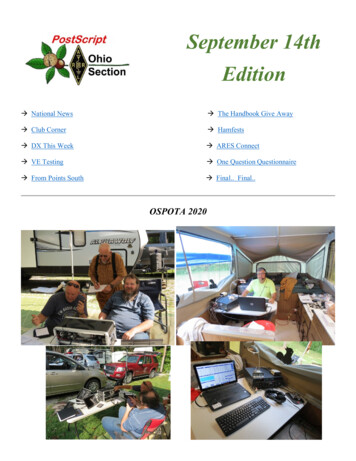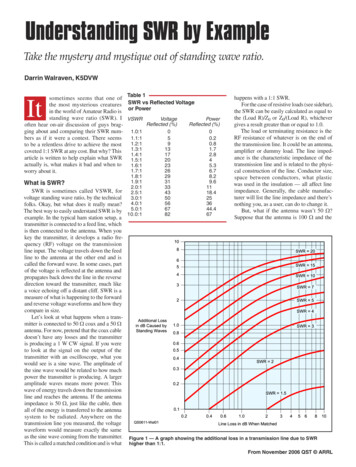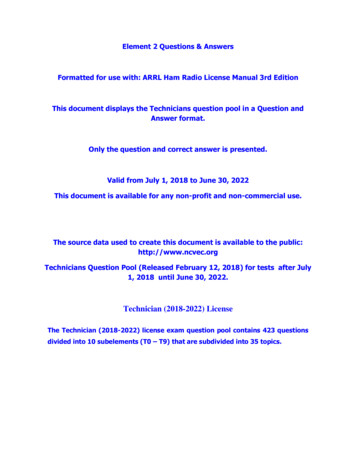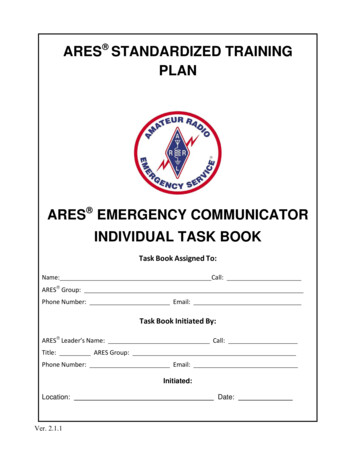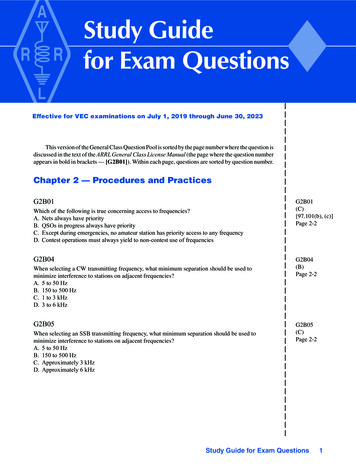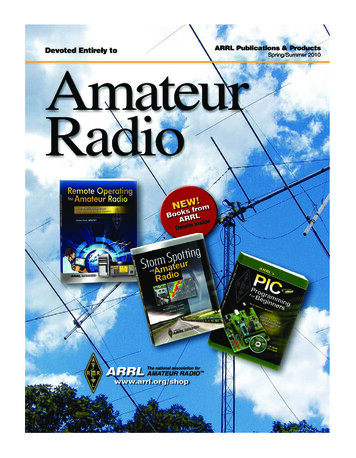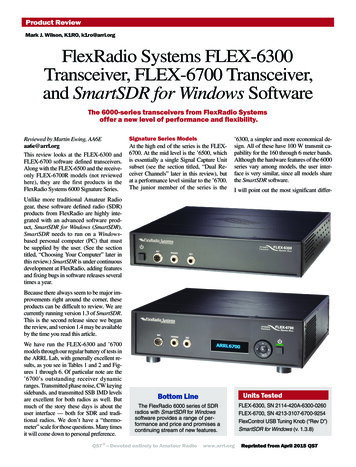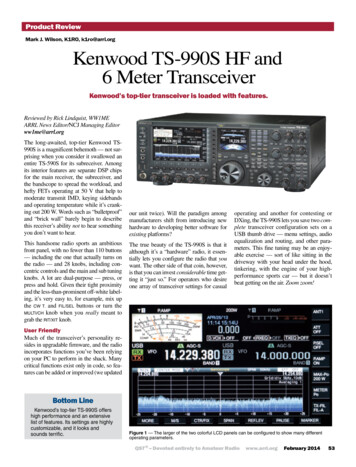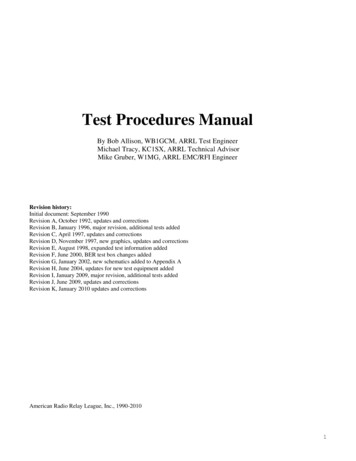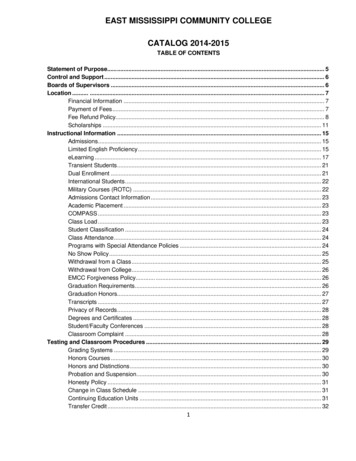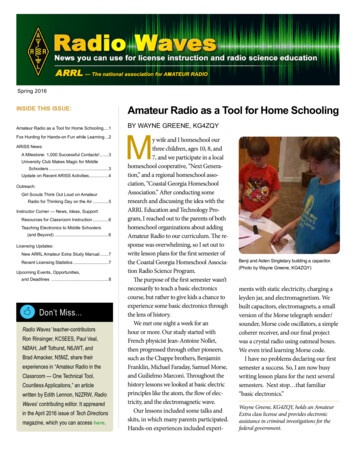
Transcription
Spring 2016Inside This issue:Amateur Radio as a Tool for Home Schooling.1Fox Hunting for Hands-on Fun while Learning.2ARISS News:A Milestone: 1,000 Successful Contacts!.3University Club Makes Magic for MiddleSchoolers.3Update on Recent ARISS Activities.4Outreach:Girl Scouts Think Out Loud on AmateurRadio for Thinking Day on the Air 5Instructor Corner — News, Ideas, Support:Resources for Classroom Instruction.6Teaching Electronics to Middle Schoolers(and Beyond) .6Licensing Updates:New ARRL Amateur Extra Study Manual 7Recent Licensing Statistics 7Upcoming Events, Opportunities,and Deadlines 8 Don’t Miss.Radio Waves’ teacher-contributorsRon Rinsinger, KC5EES, Paul Veal,NØAH, Jeff Tolhurst, N6JWT, andBrad Amacker, N5MZ, share theirexperiences in “Amateur Radio in theClassroom — One Technical Tool,Countless Applications,” an articlewritten by Edith Lennon, N2ZRW, RadioWaves’ contributing editor. It apprearedin the April 2016 issue of Tech Directionsmagazine, which you can access here.Amateur Radio as a Tool for Home SchoolingBY WAYNE GREENE, KG4ZQYMy wife and I homeschool ourthree children, ages 10, 8, and7, and we participate in a localhomeschool cooperative, “Next Generation,” and a regional homeschool association, “Coastal Georgia HomeschoolAssociation.” After conducting someresearch and discussing the idea with theARRL Education and Technology Program, I reached out to the parents of bothhomeschool organizations about addingAmateur Radio to our curriculum. The response was overwhelming, so I set out towrite lesson plans for the first semester ofthe Coastal Georgia Homeschool Association Radio Science Program.The purpose of the first semester wasn’tnecessarily to teach a basic electronicscourse, but rather to give kids a chance toexperience some basic electronics throughthe lens of history.We met one night a week for anhour or more. Our study started withFrench physicist Jean-Antoine Nollet,then progressed through other pioneers,such as the Chappe brothers, BenjaminFranklin, Michael Faraday, Samuel Morse,and Guilielmo Marconi. Throughout thehistory lessons we looked at basic electricprinciples like the atom, the flow of electricity, and the electromagnetic wave.Our lessons included some talks andskits, in which many parents participated.Hands-on experiences included experi-Benji and Aiden Singletary building a capacitor.(Photo by Wayne Greene, KG4ZQY)ments with static electricity, charging aleyden jar, and electromagnetism. Webuilt capacitors, electromagnets, a smallversion of the Morse telegraph sender/sounder, Morse code oscillators, a simplecoherer receiver, and our final projectwas a crystal radio using oatmeal boxes.We even tried learning Morse code.I have no problems declaring our firstsemester a success. So, I am now busywriting lesson plans for the next severalsemesters. Next stop that familiar“basic electronics.”Wayne Greene, KG4ZQY, holds an AmateurExtra class license and provides electronicassistance in criminal investigations for thefederal government.
Page 2Radio Waves Fox Hunting for Hands-on Fun while LearningBY CINDY POWELL, KEØFGHAfter the fox! The hunt is on for students from Rock Canyon High School.(Photo by Cindy Powell, KEØFGH)Students at Rock Canyon High School in DouglasCounty, Colorado, recently discovered Amateur RadioDirection Finding (ARDF), sometimes called foxhunting. They prepared for this by learning how to read topographical maps and how to use compasses. They also learnedabout the 2 meter Yagi antenna, the attenuator, and how radiowaves travel. They watched two videos in a flipped classroom(a model in which the typical lecture and homework elementsof a course are reversed) that asked questions about ARDF.On the day prior to the fox hunt, students went throughan orienteering course that was set up outside with 50 differentcolored flags. Each of 10 student groups had a different orienteering course for which they had to read clues, such as number of paces and degrees, to find the next flag. Each flag alsohad questions for which they had to find a correct number.At the end of each course, students had a codex that allowedthem to match up the numbers to letters. If done correctly, thewords spelled out names of Colorado mountains.The following class day, groups of six to seven students wereeach given a Yaesu FT-60R radio, a 2 meter Yagi (the studentsbuilt these), and an attenuator. I hid five Byonics Fox transmit-Orienteering/map reading graphics from handouts in fox hunting unit.ters (146.565 MHz) in different locations around the campuseach hour so they could not tell fellow classmates their locations.I had maps printed out of the campus and they had to listen tothe different signals coded in each transmitter to find the foxes.They had to show their triangulation drawings on their mapsas part of the activity. The group that found all five transmittersfirst received bonus points, which was a strong motivator.All five of my freshmen earth science students and twoother classes taught by another teacher participated. Thisallowed approximately 230 students to learn about this application of wireless technology. The students really enjoyedthe hunt, and it was fun watching them run and look forthe foxes. I am grateful to the ARRL Education & Technology Program for providing the grant for the equipment thatmade it possible to teach this in the classroom!Editor’s Note: Powell has shared the Orienteering lessonbackground that she used to prepare students for the activity.You’ll find it on the ARRL website here.Cindy Powell, KEØFGH, teaches physics and environmental/earthscience in Douglas County School District.
Page 3Radio Waves An ARISS Milestone: 1,000 Successful Contacts!At 1:07 pm on March 10, 2016, five hundred K-12 students, teachers,in the room was palpable — they had established the complex link fromUniversity of North Dakota (UND) students, and community membersNorth Dakota all the way to an orbiting research center flying 200 milessat quietly in the Memorial Union’s ballroom at UND and stared straightabove us, traveling at nearly 18,000 miles per hour. It was NASA’s his-ahead, listening attentively. The ham radio, which had been broadcast-toric 1,000th Amateur Radio on the International Space Station (ARISS)ing silence, suddenly burst with static. The voice of astronaut Tim Kopra,call — and the first ISS radio call to North Dakota. (Courtesy of CaitlinKE5UDN, Commander of the International Space Station (ISS), con-Nolby, Deputy Director ND Space Grant & ND NASA EPSCoR)firmed he could hear the radio operator “loud and clear.” The excitementThe connection was made possible through the collaboration of theNorth Dakota Space Grant Consortium (NDSGC), the Student AmateurRadio Association (SARA), and ARISS. Media coverage was extensiveand readers can share in the experience by checking out a local newsstory here and NASA’s published news piece here. More video links canbe found on the ARISS webpage at www.ariss.org/news.html.NASA Tells the ARISS StoryIn celebration of ARISS’ milestone, NASA’s public affairs office alsohas produced the following videos telling the ARISS story: www.youtube.com/watch?v bTOiiBd2dCo to hear astronaut SuniWilliams, KD5PLB, discussing what the program means to her personally https://youtu.be/Z-yHD9lVbH8 to hear astronaut Tim Peake, KG5VBI,explain how the amateur radio contacts are conducted from spaceCommemorative certificate given to students who participated in ARISS’1000th contact on March 10 at the University of North Dakota. www.youtube.com/watch?v DwtLkTpgNMM for a piece featuringcomments from several participating astronauts on the impact of ARISSUniversity of Alabama Club Makes ARISS Magic for Middle SchoolersPublic middle school and home-schooled children fromthe northern Alabama area recently thrilled to an ARISScontact thanks to the efforts of the Space Hardware Club atthe University of Alabama in Huntsville. This engineeringclub, composed of UAH students who enjoy activities likebuilding balloon payloads, satellites, and rockets outsidetheir regular classes, worked on the contact for over a yearand hosted the long-anticipated event at UAH. The luckystudents spoke with astronaut Tim Kopra, KE5UDN.NASA’s Marshall Space Flight Center has produced a videoabout the contact. It features students and staff discussing thesignificance of having the opportunity to personally speakwith an astronaut on the ISS. You’ll find it at www.youtube.com/watch?v ziSQY8E1b9w.A middle schooler asks astronaut Tim Kopra, KE5UDN, a question.
Radio WavesPage 4 Update on Recent ARISS ActivitiesIt’s been a banner year already forAmateur Radio on the InternationalSpace Station (ARISS) program,which celetrated its 1000th contact inMarch (see page 3). Other highlightsinclude include the contacts listed below. You’ll find more event details andsome links to audio/video files at www.ariss.org/news.html .STEM Trajectory Initiative withAlbuquerque Public Schools, Albuquerque, New Mexico, made a successful direct contact on April 22 viaNM5HD. Astronaut Jeff Williams,KD5TVQ, answered only six studentquestions as the signal was picked uplate in the ISS pass.The Boys & Girls Club of Washington, DC, made a successful contact onApril 16 during the USA Science andEngineering Festival, Washington, DC.Astronaut Timothy Peake, KG5BVI,answered 15 student questions.A telebridge contact via IK1SLD withstudents at the National Soaring Museum, Elmira, New York, was successfulon April 1. Astronaut Timothy Peake,KG5BVI, answered 20 questions.A direct contact via N8DEU withstudents at Walter Jackson Elementary, Decatur, Alabama, was successful on March 18. Astronaut Tim Peake,KG5BVI, answered 20 questions. Students at Booker T. WashingtonSenior High, Miami, Florida, made adirect contact via W4SVI on March 14.Astronaut Timothy Peake, KG5BVI,answered 16 student questions.A telebridge contact via W6SRJ,hosted by North Dakota Space GrantConsortium (NDSGC), Grand Forks,North Dakota, was successful onMarch 10. About 500 people were inattendance as astronaut Tim Kopra,KE5UDN, answered 19 questions forstudents from North Dakota and Min-Students ask astronaut Tim Kopra, KE5UDN,questions during ARISS’ 1000th contact onMarch 10 at the University of North Dakota.nesota. It was the 1000th scheduledcontact for the ARISS program.A telebridge contact via K6DUE withvisitors at the Atlanta Science Festival, Atlanta, Georgia, was successfulon March 8. Astronaut Tim Kopra,KE5UDN, answered 20 questions.A telebridge contact via VK5ZAIwith students at PS97 Harvey AustinSchool, Buffalo, New York, sponsoredby the National Urban Alliance forEffective Education (NUA), Syosset,New York, was successful on March1. Astronaut Tim Kopra, KE5UDN,answered 17 student questions.A direct contact via K4UAH withstudents at University of Alabama,Huntsville Space Hardware Club,Huntsville, Alabama, was successfulon February 19. Students interviewedastronaut Tim Kopra, KE5UDN, whoanswered 18 questions for students.A telebridge contact via VK4KHZwith students at Christ the KingSchool, Rutland, Vermont, was successful on February 4. Astronaut TimKopra, KE5UDN, answered 19 questions for students.For information about upcoming ARISScontacts, visit www.ariss.org/upcomingcontacts.html.An ARISS OpportunityThe next window for ARISS proposals will open in September for contacts to be scheduled July – December, 2017. For information on applying,visit ace-station, or contact Debra Johnson, K1DMJ, ARRL ARISS Program Manager,at djohnson@arrl.org.
Page 5 Radio WavesOutreachGirl Scouts Think Out Loud on Amateur Radio for Thinking Day on the AirThe World Association of GirlScouts and Girl Guides designatesFebruary 22 as Thinking Day. Andfor the second year in a row, GirlScouts in Raymond, New Hampshire,marked the occasion by transmittingtheir thoughts over Amateur Radioduring Thinking Day on the Air 2016.With the support of the NashobaValley Amateur Radio Club, theyoungsters enjoyed a terrific learning experience. Girl Scout leader JillGalus, KB1SWV, offers the followingobservations:This year [the event] was moved toa larger venue with multiple rooms toimprove traffic flow and QRM. Operators from last year felt that 85 girlsin one room was one of the factorscontributing to the limited contacts.This year the event had three rooms,a large assembly hall for communica-tion experiments, a classroom for codepractice — both phonetic alphabetand Morse code — and a code craft,and another classroom across thehall to learn about time zones and toget on the air! Most of the activitieswere taken from the ARRL Radio andWireless Technology Patch. This year’sevent was even more successful thanlast year’s!Working as a team, Jill and herfather, Skip Youngberg, K1NKR, aretaking the promotion of Thinking Dayon the Air on the road to local clubsand Girl Scout troops. They have prepared a presentation explaining theactivity, its opportunities, and the newGirl Scout Radio & Wireless Technology Patch program (see sidebar) thatis being shared for use by other clubsinterested in reaching out to localGirls Scouts. Check it out here.Girls Scouts Can NowEarn Radio & WirelessTechnology PatchARRL is offering a new Radio & WirelessTechnology Patch program for Girls Scouts.Scout leaders and Amateur Radio volunteersassociated with the Greater Atlanta Girl ScoutCouncil and Girl Scouts of the Green andWhite Mountains developed the program toincorporate information and exploratory activitiesthat provide a backdrop for understandingradio communication. The program offersopportunities to learn about wirelesstechnologies, including Amateur Radio. GirlScouts will be encouraged to take on activitiesthat engage, educate, and empower themand kindle an interest in Science, Technology,Engineering, and Math (STEM) subjects andcareers. The program defines requirements forGirl Scouts to earn the patch at the Brownie,Junior, Cadette, Senior, and Ambassador levels.More information, as well as an online form toreport on patch activities, can be found on theARRL website at www.arrl.org/girl-scouts-Anita Kemmerer, AB1QB, made contacts and helped the girls speak to amateur stations duringThinking Day on the Air. (Photo by Ralph Swick, KD1SM)radio-patch.
Page 6 Radio WavesInstructor Corner — News, Ideas,SupportResources for Classroom InstructionInstructors looking for new ideas to freshen up their lessons and help students prepfor exams as well as operating should check out the following Internet resources:Beverly Matheson, WA6BK, teacher at Dorothy Grant Elementary School in Fontana,California, and David Collingham, K3LP, the school’s radio club advisor, have developed workbooks and labs for teaching elementary students hamradio operating skills and radio basics. Check out “Amateur Radio Information& Best Practices Student Workbook, ARS-SWB-1000”; “Electronics Theory& Communications Student Workbook, ETC-SWB-1001”; and “Electronics &Communications Lab, ECL-SWB-2001.”Knowledge and nostalgia meet in a 1940’s 10-minute short called, “Sending RadioMessages, Principles of Radio – Part One.” Point your web browser tothe url found here.Video courses on radio technology, which run 3 – 5 minutes each and present.topics simply and clearly, can be foundMembers of the Dorothy GrantElementary School radio club,K6DGE, on the air from Fontana,California. (Photo by BeverlyMatheson, WA6BK)hereTeaching Electronics to Middle Schoolers(and Beyond)Retired electronics engineer, volunteer science teacher, and occasional QST authorCharles Kitchin, N1TEV, has made his 7th grade “Intro to Electricity” lesson available on YouTube. Recorded at Wilmington Middle School, Wilmington, Massachusetts, it runs about 30 minutes and covers voltage, current, resistance, plus series andparallel electric circuits.According to Kitchin, this unedited video provides an excellent hands-on classroomlesson and all necessary materials are available at Radio Shack. You can find “Intro toElectricity” at www.youtube.com/watch?v maLt5zVaV6E.Higher level students and their teachers may also be interested in his advanced offerings in “Updating Classic Regen and Super Regen Presentation.” They can be found at:Part 1: www.youtube.com/watch?v gcr7hSjTqd8Part 2: www.youtube.com/watch?v 3ZHsmVGWldg Cool Tool forOutreachNew Video Release from theRadio Society of Great BritainThe Radio Society of Great Britain(RSGB) has produced a new andengaging video called, “Amateur Radio— A Hobby for the 21st Century.” Thislively introduction to ham radio activitiesalso presents opportunities to fire upnew recruits! You’ll find it posted to theweb here.
Page 7 Radio WavesNew ARRL Amateur Extra Study ManualThe new The ARRL Extra Class LicenseManual (11th edition) reflects the changesto the new exam. The biggest area ofchange is digital mode signals. Digitaltechnology is evolving rapidly, and hamsmust have the proper tools to evolve withit. The Extra Class License Manual presents the fundamental “know-how,” so theanswers make sense and will be remembered after the exam has been passed.Other updated areas include propagation,software-defined radio, electronic circuitsand components, and antennas.There have been a few minor erratanoted in the book, which ARRL will berevising with supplements and errataon a regular basis. This can be found atwww.arrl.org/eclm as a downloadablePDF and includes any errors found inthe Q&A as well. While the League triesits best to get everything right the firsttime, a few slip-ups are inevitable, andwe are thankful for sharp-eyed readerswho report any problems. Those areincorporated into the errata right awayand fixed in any subsequent printing.The new 11th edition will also beavailable in spiral bound and Kindleversions. Order print editions from theARRL store here.New The ARRL Extra Class LicenseManual (11th edition).Recent Licensing StatisticsThis report of new FCC licenses issuedis supplied by Maria Somma, AB1FM,ARRL VEC Manager.NEW FCC LICENSES ISSUED 2011 THROUGH APRIL 7227,08228,88633,24132,07712,241*March 2016 is a record month for new licenses.Somma notes that the growth of newlicensees is continuing through the beginning of 2016. During the first fourmonths, the FCC issued 12,241 newlicenses, a 6% gain in new Amateursover the same period last year.If this trend continues, we should see32,000 new Amateurs by the end ofthis year!
Page 8 Contact Us:ARRL Education Services225 Main StreetNewington, CT 06111Debra Johnson, K1DMJEducation Services ManagerRadio Waves Editor(860) 594-0296djohnson@arrl.orgEdith Lennon, N2ZRWRadio Waves Contributing EditorVisit Us:Resources for License ructionRadio WavesAnnouncements, Upcoming Events,Opportunities, and DeadlinesARISS Proposal Window, September 2016 — The ARISS Program’s proposalwindow for accepting submissions from educational organizations seeking tohost scheduled contacts with the ISS between July – December 2017 will open inSeptember. Details and opportunities to participate in Information Sessions will beposted at www.arrl.org/hosting-an-ariss-contact.School Club Roundup (SCR), October 17 – 21, 2016 — This biannual event fosterscontacts with and among school radio clubs. For more information, visit www.arrl.org/school-club-roundup.Jamboree on the Air (JOTA), October 15 – 16, 2016 — Jamboree-on-the-Air is anannual Boy Scouts of America (BSA) event that uses Amateur Radio to link Scoutsaround the world, around the nation, and within communities. Contact your local Scout council, a local ham, or a local Amateur Radio club to see what may beplanned in your area. Register your station on the BSA website here.Resources for mEducation & Technology Program:www.arrl.org/education-Education & Technology Program Grant DeadlineEducation & Technology Program (ETP) GrantApplication Deadline, November 1, 2016 — Thistechnology-programARRL education support program offers two types ofTeachers Institute on WirelessTechnology:Grants. Find out more about the grants and thewww.arrl.org/teachers-institute-grants: ETP School Station Grants and ETP Progressapplication process at S onal-space-stationYou are subscribed to receive the ARRL Instructor/Teacher E-Letter. Ifyou have an ARRL website user account, you can manage all of youre-mail preferences at www.arrl.org/myarrl. If not, contact us at ead@arrl.org to subscribe/unsubscribe.Access Radio WavesFind this and other issues of RadioWaves in interactive online format atwww.arrl.org/radio-wavesCopyright 2016, ARRL, Inc.All Rights Reserved225 Main Street Newington, CT USA 06111(860) 594-0200 www.arrl.org
School, Buffalo, New York, sponsored by the National Urban Alliance for Effective Education (NUA), Syosset, New York, was successful on March 1. Astronaut Tim Kopra, KE5UDN, answered 17 student questions. A direct contact via K4UAH with students at University of Alabama, Huntsville Space Hardware Club, Huntsville, Alabama, was successful
